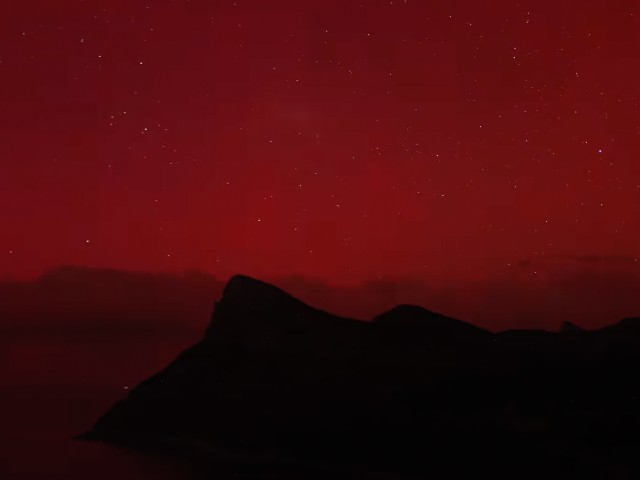
-
In Case You Missed The Southern Lights Show On Full Display Over Parts Of South Africa On Friday [Images]
13 May 2024 by Tayla in Environment, Nature, Science, South Africa, Space, Tech/Sci, Weather, World
[imagesource: Facebook/Gianluca de Gasparis/SEVERE WEATHER AND INFORMATION CENTRE SA]
Saffas only had a moment to feel slighted by the sky on Friday, when folks from across Europe, in the United States and as far as New Zealand began sharing images of colourful Northern Lights (Aurora Borealis) sightings.
While we all freaked out about our WhatsApp messages from the North, the sky above South Africa was getting supercharged.
Then, we were treated all the same to a show of the elusive Southern Lights, or the Aurora Australis. If you didn’t manage to catch them in real time, don’t worry, we’ve got you. There are a bunch of cool images taken by Saffas at home and spread across the world, who joined the global responses to the historic solar storm that impacted Earth this weekend.
Night skies were lit up by these bright colour lights in locations where they don’t normally shine as a severe solar storm supercharged the phenomenon.
More passion!☀️
More passion!☀️
More energy!💥
More energy!💥Another M8.8-class flare just erupted from the Sun!
Here’s SDO’s view: pic.twitter.com/KmyIZMqVTe— NASA Sun & Space (@NASASun) May 11, 2024
Friday’s storm was the first severe geomagnetic storm watch issued since 2005, reaching intensity G5 on a 1-5 scale on Saturday in the Northern hemisphere, making it the strongest storm to reach Earth’s atmosphere since October 2003’s “Halloween Storms,” said Bryan Brasher, National Oceanic and Atmospheric Administration’s Space Weather Prediction Center spokesperson via NBC News.
According to the South African National Space Agency (Sansa), the storm happened throughout the night on Friday and continued into Saturday, per TimesLIVE.
Sansa’s Space Weather Centre issued several G4 warnings and, for the first time since 2003, one G5 warning was issued. These are readings on the geomagnetic storm scale that indicates the severity of geomagnetic storms, rated from 1 to 5, with 1 a minor event and 5 an extreme event.
According to Vaneshree Maharaj, a spokesperson for the agency, a solar storm happens when charged particles emitted by the sun collide with Earth’s magnetic field. Typically, the effects are limited to technological systems, manifesting most visibly as the auroras in the northern and southern hemispheres.
“We haven’t seen anything like this since about 2003. The beautiful spectacles you see happen when protons, neutrons and electrons in the air all react differently and glow strange colours,” she said, explaining why some parts of the planet saw different colours in the sky.
“Normally it’s confined to the North and South poles, but because this one was so substantial people saw it spreading out towards the middle of the planet. Had the G5 storm grown worse or continued for longer I think we might have been able to see something in Gauteng.”
Then again, people in bigger cities, like London, won’t really be able to see something so special because light pollution tends to cancel out the brightness of the coloured lights.
Amazing photo of the Aurora australis over Cape Town, South Africa last night. See https://t.co/XtcjgE7hir for more. #aurora #southernlights #southafrica #solarstorm @elonmusk pic.twitter.com/OkctCYdgyJ
— Snow Report Southern Africa (@SnowReportSA) May 11, 2024
South Africans shared photographs online of red and purple-coloured skies as the Aurora Australis showed off from the Cape all the way up to Namibia.
Aurora Borealis was witnessed across the northern hemisphere.
View this post on InstagramView this post on InstagramUntil next time, we hope.
Latest News
-
Powerful South African Short Film ‘The Last Ranger’ Scoops Up Awards And International Praise
[imagesource: Cindy Lee Director/Facebook] A compelling South African short film, The L...
-
Caprice Summer Has Started With Brunch (But Better) This Saturday + Other Lush Camps Bay Parties
[imagesource: Instagram/cafecaprice] Is it just me or has Summer been taking its sweet ...
-
Notre-Dame Cathedral In Paris Restored And Ready For Grand Reopening After Devastating Fire
[imagesource:wikimedia] After five years of work and millions in donations, The Notre-D...
-
Self-Destructing Number Plates: The Future Of Gauteng’s Roads Or Spy-Tech Fantasy?
[imagesource:worldlicenseplates.com] What sounds like a James Bond movie is becoming a ...
-
I Changed My Relationship With Food And You Won’t Believe What Happened Next
[imagesource:supplied] As the festive season approaches, it's time to deck the halls, g...
-






























